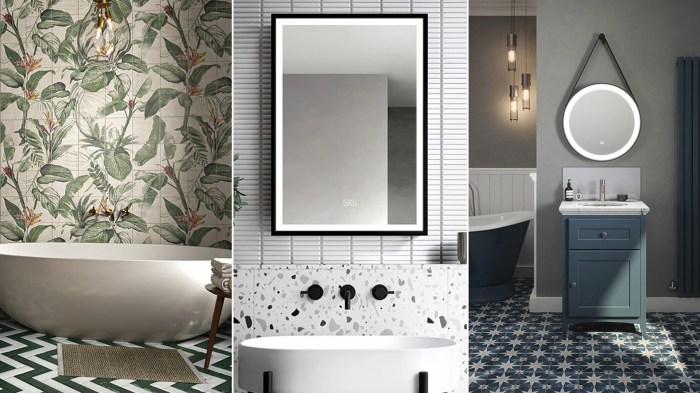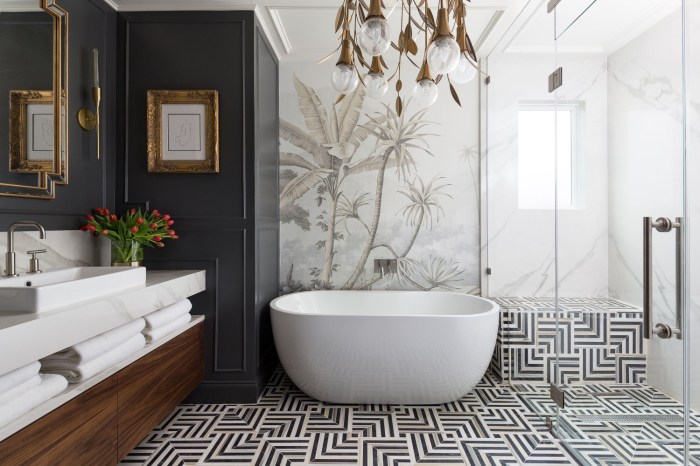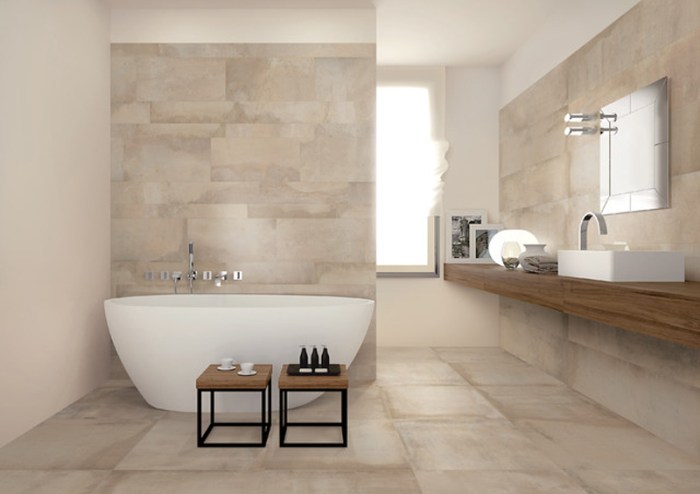Transforming your bathroom into a personalized haven is a delightful endeavor, and one of the most effective ways to achieve this is through the creative use of tiles. Mix and match tile ideas offer endless possibilities for expressing your style and creating a bathroom that is both visually appealing and functional.
In this guide, we will delve into the world of mix and match tiles for bathrooms, providing you with inspiration, practical advice, and tips to help you create a space that is uniquely yours. Whether you prefer a classic, modern, or eclectic aesthetic, you will find valuable insights to guide you on your journey to a personalized bathroom sanctuary.
Design Inspiration
Personalize your bathroom with mix and match tiles to create a unique and stylish space. Experiment with different colors, patterns, and textures to reflect your personal style.
Incorporate the latest trends in bathroom tile design, such as large-format tiles, geometric patterns, and metallic accents. Mix and match different tile shapes and sizes to create a dynamic and visually appealing look.
Mix and Match Tile Combinations
- Combine white subway tiles with black hexagonal tiles for a classic and modern look.
- Pair patterned cement tiles with solid-colored tiles for a bohemian and eclectic style.
- Use a mix of glass tiles, ceramic tiles, and stone tiles to create a luxurious and spa-like atmosphere.
Tile Selection
Selecting tiles for your bathroom is a crucial step in creating a personalized and stylish space. With a wide variety of options available, choosing the right tiles can enhance the overall aesthetic and functionality of your bathroom.
Tiles come in various types, including ceramic, porcelain, natural stone, glass, and mosaic. Each type offers unique characteristics and benefits. Ceramic tiles are durable, affordable, and come in a vast range of colors and patterns. Porcelain tiles are denser and more water-resistant than ceramic tiles, making them suitable for areas with high moisture.
Natural stone tiles, such as marble, granite, and limestone, add a touch of luxury and sophistication to your bathroom but require regular sealing to maintain their appearance.
Choosing Complementary Tiles
When selecting tiles, consider their size, shape, color, and texture to create a cohesive and visually appealing design. Smaller tiles, such as mosaics, can add detail and interest to your bathroom, while larger tiles can create a more spacious and modern look.
The shape of the tiles, such as square, rectangular, or hexagonal, can also impact the overall style of your bathroom. Choosing tiles with complementary colors and patterns can create a harmonious and inviting space.
Factors to Consider
In addition to aesthetics, consider practical factors when selecting tiles. The size and shape of your bathroom, the amount of natural light, and the overall design scheme should influence your choice. For smaller bathrooms, lighter colors and smaller tiles can help create the illusion of space.
Natural stone tiles require regular sealing to maintain their appearance and prevent staining, while ceramic and porcelain tiles are generally easier to clean and maintain.
Conclusion
Choosing the right tiles for your bathroom is essential for creating a personalized and functional space. By considering the different types of tiles available, their complementary characteristics, and practical factors, you can select tiles that enhance the overall aesthetic and functionality of your bathroom.
Layout and Installation
Crafting a visually stunning mix and match tile layout requires careful planning. Begin by envisioning the overall aesthetic you desire. Experiment with different tile shapes, sizes, and patterns to create a harmonious blend. Consider using contrasting grout colors to highlight specific areas or patterns.
When it comes to installation, you have several options. The most common method is the thin-set method, which involves applying a layer of thin-set mortar to the substrate and then pressing the tiles into place. Another option is the mastic method, which uses a pre-mixed adhesive.
For larger tiles or heavy-duty applications, a medium-bed mortar may be required.
Grouting and Sealing
Once the tiles are installed, it’s time to grout and seal them. Grouting fills the gaps between tiles and helps prevent water damage. Choose a grout color that complements your tiles and apply it using a grout float. Allow the grout to dry completely before sealing it with a penetrating sealer.
This will protect the grout from stains and moisture.
Color and Pattern Combinations
Color and pattern combinations are essential for creating visually appealing tile designs. Color theory plays a crucial role in selecting colors that complement each other, creating a harmonious and cohesive look.
Complementary color schemes involve using colors opposite each other on the color wheel, such as blue and orange or red and green. These combinations create a vibrant and eye-catching effect.
Contrasting Color Schemes
Contrasting color schemes utilize colors that are far apart on the color wheel, such as blue and yellow or red and purple. These combinations provide a bold and striking look that can add depth and interest to a space.
Incorporating Patterns
Incorporating patterns into a mix and match tile design can add visual interest and personality. Geometric patterns, such as hexagons, chevrons, or stripes, can create a modern and sophisticated look. Floral or organic patterns, such as leaves or flowers, can bring a touch of nature and tranquility to a bathroom.
Accessories and Decor
Mix and match tiles provide a versatile canvas for accessorizing your bathroom. Consider the overall style and color scheme when selecting accessories, ensuring they complement the tile design.
Incorporate elements like plush towels, elegant shower curtains, and decorative baskets to enhance the ambiance. Fixtures, mirrors, and artwork can also play a significant role in tying the look together.
Balancing Patterns and Textures
When mixing patterns and textures, strive for a harmonious balance. Choose tiles with complementary patterns that enhance each other, avoiding overwhelming the space. For instance, a bold geometric tile could be paired with a subtle textured tile to create a visually interesting yet cohesive design.
Consider the scale of the patterns as well. Large-scale patterns can dominate the room, while smaller patterns add visual interest without overpowering the space.
Maintenance and Care
Maintaining mix and match tiles requires regular cleaning and proper care to preserve their beauty and longevity. Proper maintenance can prevent dirt, grime, and stains from accumulating, which can dull the tiles’ appearance and damage the grout.
Cleaning Solutions
Use pH-neutral cleaning solutions specifically designed for tile surfaces. Avoid harsh chemicals, abrasive cleaners, or acidic solutions, as these can damage the tiles or grout. Always test the cleaning solution in an inconspicuous area before applying it to the entire surface.
Final Conclusion
Mix and match tile ideas for personalized bathrooms offer a limitless canvas for creativity and self-expression. By carefully considering the design principles, tile selection, layout, color combinations, and accessories, you can transform your bathroom into a space that reflects your unique style and brings joy to your daily routine.
Remember, the key to a successful mix and match tile design lies in finding the perfect balance between aesthetics and functionality, creating a bathroom that is both visually stunning and a pleasure to use.



